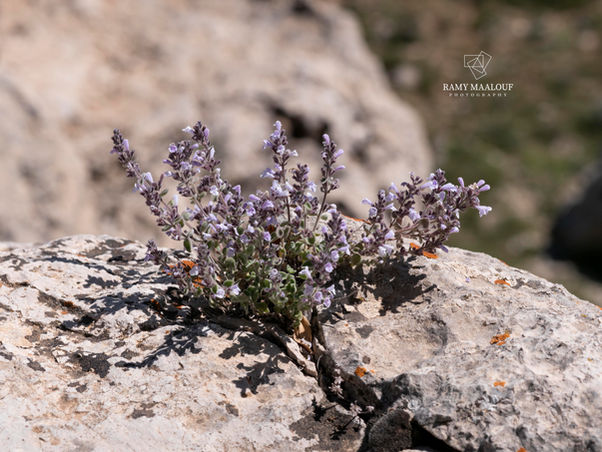Family |
Lamiaceae
Clinopodium libanoticum
(Boiss.) Kuntze

Endemic to Lebanon
Clinopodium libanoticum (Boiss.) Kuntze
≡ Origanum libanoticum Boiss. — Amaracus libanoticus (Boiss.) Briq.
(Revis. Gen. Pl. 2: 515; 1891. — Nouvelle Flore du Liban et de la Syrie, vol. 3, p. 186; 1983, as Origanum libanoticum)
• Life-form & habit: Perennial, subshrub at base, many-stemmed, 30–60 cm tall. Stems leafy, often paniculate above, rigid, glabrous.
• Leaves: Pale green, ovate, obtuse, shortly petiolate, somewhat distant on the stem; upper leaves very reduced, sessile.
• Inflorescence & flowers: Peduncles naked, slender, horizontal or spreading, up to 3 cm. Floral spikes ovate, often nodding, rather loose at maturity. Bracts ample, 8–12 × 8–10 mm, obtuse or subacute, strongly tinged purple (rarely whitish-green by albinism), concealing the flowers except for the tips of the exserted stamens. Calyx bilabiate, to just above the middle, lips subequal: lower with two subacute teeth, upper entire or with three short rounded teeth. Corolla more than twice the length of calyx, bilabiate, rose, with spreading lower lip; stamens long-exserted.
• Fruit: As in Clinopodium, 4 small nutlets, not described in detail by Mouterde.
• Phenology: Flowers spring–summer.
• Habitat & elevation: Woodlands and grassy places.
• Lebanese distribution: Mi–Mm: Choueir, Nahr Ibrahim, Chahtoul, Khan Sannine, El-Farat, Douma, Bchéla, Jabal Mnei‘tri, Ghazir–Afqa, Afqa, ‘Aqoura, ‘Aqoura–Mejdel, ‘Aïtou, Ehden, N of Ehden, Mar Moussa, Sir-ed-Denniyé, Bcharré Cedars, Fneideq, Jabal Qamoua, base of Jabal ‘Aqroum.
• Native range: Endemic to Lebanon













